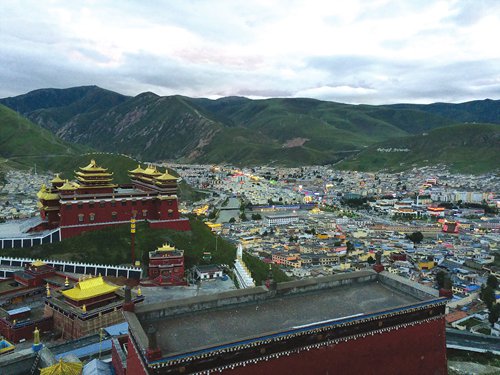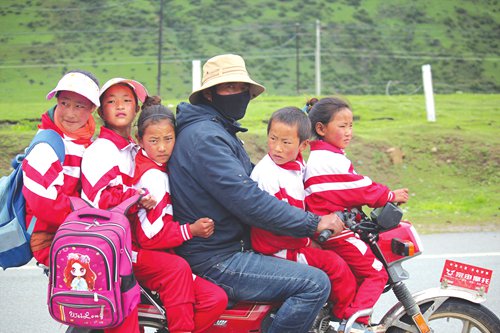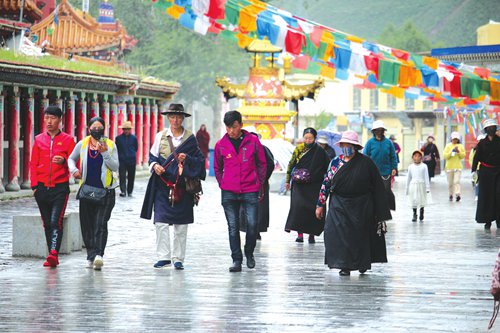HOME >> LIFE
Road trip through Qinghai and Northern Sichuan
By Peter Krasnopolsky Source:Global Times Published: 2019/8/11 13:06:46

Doendrub Monastery in the Yushu Tibetan Autonomous Prefecture, Qinghai Province Photo: Courtesy of Rainer Feldbacher

Young students get a ride on a motorcycle in Qumarleb county, Qinghai Province Photo: Courtesy of Rainer Feldbacher

People visit the Mani Wall in Yushu. Photo: Courtesy of Rainer Feldbacher
Bored with city life, my friends and I decided to go on a road trip in late June.
We left Beijing and drove through the desert of North China's Inner Mongolia, crossed the narrow section of Gansu Province and then faced the Qilian Mountains, which separates the valley from the Qinghai-Tibetan Plateau.
The initial climb was smooth, but when we stopped in a cozy town on the other side of the mountain pass, the difference was stark. The small excursion to enjoy typical Tibetan architecture turned into a proper fitness test. Half of our party was gasping for air. At the top of the next pass, 4,200 meters above sea level, the temperature dropped to 5 C. We attempted to "check out the view," but could see absolutely nothing behind a white wall of fog and freezing rain, which forced us back into our cars.
I ended up getting woozy and had to inhale oxygen from a canister before I could continue driving. The car engine stalled several times and had to be revved before we managed to make some progress back down.
Island mentality
Over the next few days on the Qinghai-Tibeta Plateau, we would stay at heights up to 5,000 meters above sea level. Just like the travel guides suggested, the altitude sickness hit everybody differently. One of our younger peers, an intrepid traveler, who had climbed nearly 6,000 meters of Kilimanjaro without any difficulties, followed every advice of managing altitude sickness, including abstinence from physical activities and alcohol. Yet he still became nearly dysfunctional and spent two days attached to an oxygen pillow in a hotel room. Others, slightly older, kept moving around, never skipped baijiu at dinner, went through a pack of cigarettes a day, and showed no sign of the slightest discomfort. Yours truly spent several sleepless nights gasping for air.
The chosen route to Qinghai Lake ran through picturesque landscapes on a rough dirt track alternating with gravel. In some parts we had to wait as recent mudslides were cleared by industrious excavators.
As we stopped for yet another photo, a smiling young local pulled over on a motorcycle. He showed us the results of his daily dig for Caterpillar Fungi, a worm-looking mushroom praised for its aphrodisiac characteristics and other medicinal qualities. The man offered to sell his product for 60 yuan ($8.50) a piece. After bargaining the price down to 50, each member of our party happily purchased a worm-looking mushroom without having any idea of how to use it.
At the end of the trip we stumbled onto a traditional medicine shop in Northern Sichuan which sold Caterpillar Fungi for 30 yuan a piece.
That evening we arrived to the less touristy north bank of Qinghai Lake. The dingy hotel was separated from the water front by a wide stretch of pasture land.
In the morning, after we waved away the swarms of flies from the windows, we were treated with a magnificent view of China's largest inland body of water, with yaks grazing on the adjacent grasslands and sand dunes rising high to the west.
We made our way to the bank by dodging yak dung and entrepreneurial locals who were attempting to collect the "toll fees" on a public road. The couple from our troop split away and came back hours later claiming to have gone skinny dipping in a completely secluded section of the shoreline - a courageous act, especially on the part of the young man considering that the water was very cold.
As we circumvented the lake and continued further south and higher up the plateau, the grasslands became replaced by moss and low shrubs and the pavement of the road became increasingly cracked and bent - a result of permafrost. As we were climbing another 4,000-plus pass, one of the rear tires went flat. The cause of the puncture was a sharp rock jammed in a thread for who-knows-how-long. Luckily, the only drama about changing a tire at a high mountain pass was that unfastening and fastening the locknuts was a strenuous exercise that left most of us breathless.
The road was mainly empty, but each of the few trucks which went by stopped and asked whether we needed any help. This simple act of care, which is so rarely seen among the dwellers of large urban centers in China, suggested elements of an "island mentality" among the occupants of the Qinghai-Tibet Plateau. The idea is that you help a stranded stranger. After all, the mighty plateau is more isolated and less accessible than many of the real islands in the ocean.
Tibetan summer
That evening we dropped anchor in a tiny town called Huashixia, which translates into the idyllic-sounding Fossil Gorge. The town is in Madoi county, Golog Tibetan Autonomous Prefecture in Qinghai Province, which happens to be the highest Chinese county by average elevation.
We examined five family-run hotels within a block radius. Each had only one toilet to share among half a dozen rooms. The hotel we chose had the only sit-down toilet; as a bonus, the receptionist rested on a king size bed behind the counter.
After checking in, we went for a stroll down the muddy street to find food and a mechanic to fix our tire.
The town was planted in a beautiful background, but that day my perception of the Tibet plateau as a serene place was completely dismantled. Minutes into our stroll around Fossil Gorge, a massive wind picked up, preventing us from walking and filling our eyes and noses with dust. The sand storm stopped as suddenly as it started, and the skies opened up with a massive downpour. The weather seemed as capricious as a teething infant who throws a tantrum at random. A new Tibetan friend told us that traditional local outfits reflect the inability to predict what to wear for the day and that we were there in the warmest time of the year.
The romanticism of the world's deserts, snow-capped peaks and arctic oceans lies behind the lens of a camera. The Qinghai-Tibet Plateau beauty hides the notion that it is one of the least hospitable natural environments settled by people. This provides additional understanding for the "island mentality" of the occupants of the plateau - avoid confrontation with fellow human beings because you need all of your energy to deal with nature. Tibetans are friendly, soft-spoken, dignified and curious about outsiders.
These characteristics greeted us in Qumarleb, one of the county seats in Qinghai's Yushu Tibetan Autonomous Prefecture. The road to Qumarleb was marked by a very fresh solid yellow line painted on permafrost-crooked pavement. We followed the line for a few kilometers and when it stopped we stopped to have a chat with a crew of young civil engineers. They came from provincial capital Xining to mark roads in this remote area. They said that in six weeks, before it starts snowing in August, they should be able to finish the solid yellow line to Qumarleb. As for us, we managed to get to Qumarleb by the end of the day.
A local teacher offered us the warmest welcome, which included a traditional Tibetan meal, local sightseeing and a barbecue by the local river - not an easy feat considering that at 4,200 meters the weather was even more capricious, the air was even more deprived of oxygen necessary to sustain fire and the firewood was non-existent. We used charcoal and tried yak poo as fuel. The highlights of the program included yak riding and yak hot pot, involving two different yaks.
Down the hill and home
As we left Qumarleb, we stopped in Yushu to enjoy the wonderful bird's eye view of the city and explore the largest wall of the Buddhist stone scriptures in the world. Further east, as we crossed into northern Sichuan, the Qinghai-Tibet Plateau continued to amaze us with natural views, traditional towns and colorful monasteries embedded in the valleys and perched on the edges of the mountains. The city of Ganze presented a spectacular example of original Tibetan architecture. And as we spent the night in Zhuqing town, we stayed in a traditional Tibetan style house, but enjoyed the most amazing meal, complements of the proximity of the Sichuan food culture. After all, as wonderful as the plateau and its occupants are, Tibetan cuisine is plain and basic, and we were excited to sweat and sneeze through the powerful flavor of Sichuan peppers.
As we were descended the plateau through Wenchuan county, the winding roads and increasingly wooded gorges continued to surprise as we encountered a troop of several dozen monkeys crossing the road.
As we descended, in a matter of hours, we realized that it was the middle of summer. The breathing became easy and we took off out jackets and sweaters and changed into short. In two days we drove from northern Sichuan back to Beijing. We were too tired to stop on the way. More importantly, we knew that few places would match what we have experienced on Qinghai-Tibetan Plateau, at least for now.
Newspaper headline: Mountain high
Posted in: FEATURE,ADVENTURES